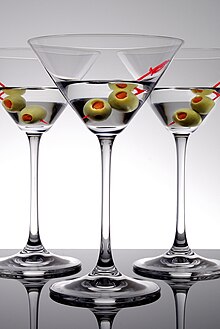The following outline is provided as an overview of and topical guide to meals:
Elevenses is a short break taken at around 11:00 a.m. to consume a drink or snack. The names and details vary among countries.

A tavern is a type of business where people gather to drink alcoholic beverages and be served food such as different types of roast meats and cheese, and where travelers would receive lodging. An inn is a tavern that has a license to put up guests as lodgers. The word derives from the Latin taberna whose original meaning was a shed, workshop, stall, or pub.

The martini is a cocktail made with gin and vermouth, and garnished with an olive or a lemon twist. Over the years, the martini has become one of the best-known mixed alcoholic beverages. A popular variation, the vodka martini, uses vodka instead of gin for the cocktail's base spirit.
A free lunch is the providing of a meal at no cost, usually as a sales enticement to attract customers and increase revenues from other business. It was once a common tradition in saloons and taverns in many places in the United States, with the phrase appearing in U.S. literature from about 1870 to the 1920s. These establishments included a "free" lunch, which varied from rudimentary to quite elaborate, with the purchase of at least one drink. These free lunches were typically worth far more than the price of a single drink. The saloon-keeper relied on the expectation that most customers would buy more than one drink, and that the practice would build patronage for other times of day.

Happy hour is a marketing term for a time when a venue such as a restaurant or bar offers reduced prices on alcoholic drinks. Discounted menu items like appetizers are often served during happy hour. This is a way for bars and restaurants to draw in more business before or after peak business hours.

Apéritifs and digestifs are drinks, typically alcoholic, that are normally served before (apéritif) or after (digestif) a meal.

The Center for Science in the Public Interest (CSPI) is a Washington, D.C.-based non-profit watchdog and consumer advocacy group that advocates for safer and healthier foods.
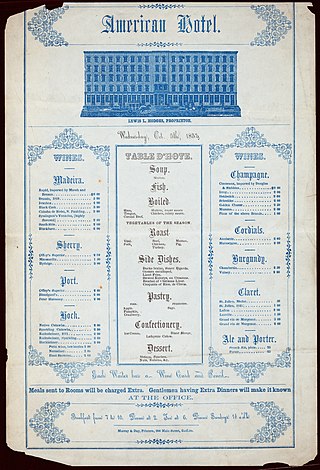
In restaurant terminology, a table d'hôte menu is a menu where multi-course meals with only a few choices are charged at a fixed total price. Such a menu may be called prix fixe. The terms set meal and set menu are also used.

A school meal is a meal provided to students and sometimes teachers at a school, typically in the middle or beginning of the school day. Countries around the world offer various kinds of school meal programs, and altogether, these are among the world's largest social safety nets. An estimated 380 million school children around the world receive meals at their respective schools. The extent of school feeding coverage varies from country to country, and as of 2020, the aggregate coverage rate worldwide is estimated to be 27%.
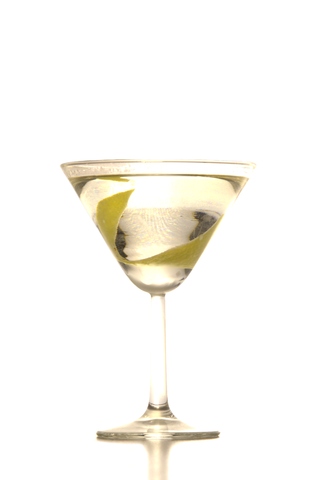
The Vesper is a cocktail that was originally made of gin, vodka, and Kina Lillet. Since that form of Lillet is no longer produced, modern bartenders need to modify the recipe to mimic the original taste.

Alcoholic drinks in Sweden are as common as in most of the western world. Sweden is historically part of the vodka belt, with high consumption of distilled drinks and binge drinking, but during the later half of the 20th century, habits are more harmonized with western Europe, with increasing popularity of wine and weekday drinking. Wine is now also grown and produced in several parts of Sweden and the southernmost region of Skåne is turning into a hub experiencing a strong growth in number of active vineyards.

Merienda is a light meal in southern Europe, particularly Spain, Portugal and Italy (merenda), as well as Hispanic America, The Philippines (meryenda/merienda), North Africa (Morocco), and Brazil. Usually taken in the afternoon or for brunch, it fills in the meal gap between the noontime meal and the evening meal, being the equivalent of afternoon tea in the English-speaking world; or between breakfast and lunch. It is a simple meal that often consists of a piece of fruit, bread, cookies, yogurt, and other snacks paired with juice, milk, hot chocolate, coffee, spirits, or other beverages.
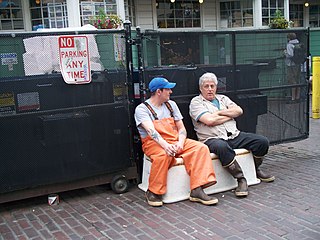
A break at work is a period of time during a shift in which an employee is allowed to take time off from their job. It is a type of downtime. There are different types of breaks, and depending on the length and the employer's policies, the break may or may not be paid.
Lunch is a meal eaten around the middle of the day. It is commonly the second meal of the day, after breakfast, and varies in size by culture and region.
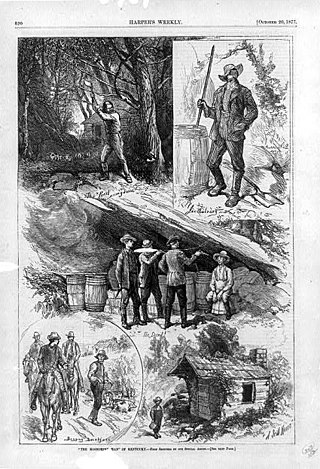
Nip joints, found most commonly in Appalachia and similar areas where corn is grown in abundance, are venues where illegal liquor is sold, often by the drink. Most nip joints are located in residential areas inside homes. The individual in charge is therefore referred to as the "House Man" or "House Lady". Some nip joints have more amenities than others.

The espresso martini, also known as a vodka espresso, is a cold caffeinated alcoholic drink made with espresso, coffee liqueur, and vodka. It is not a true martini as it contains neither gin nor vermouth, but is one of many drinks that incorporate the term martini into their names.

Retail food delivery is a courier service in which a restaurant, store, or independent food-delivery company delivers food to a customer. An order is typically made either through a restaurant or grocer's website or mobile app, or through a food ordering company. The delivered items can include entrees, sides, drinks, desserts, or grocery items and are typically delivered in boxes or bags. The delivery person will normally drive a car, but in bigger cities where homes and restaurants are closer together, they may use bikes or motorized scooters.
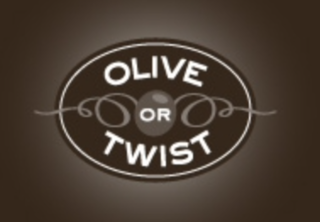
Olive or Twist is a cocktail bar in Portland, Oregon's Pearl District, in the United States.
